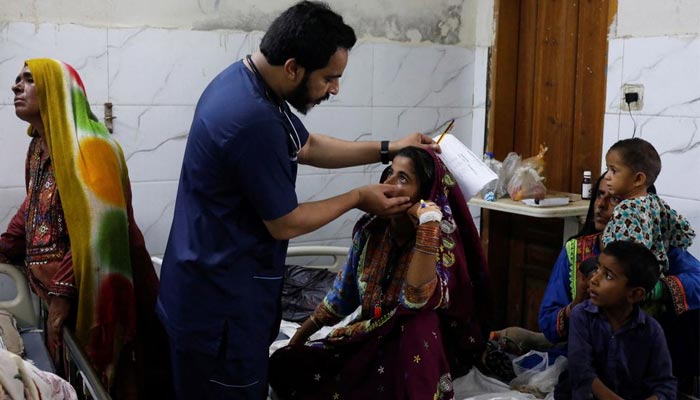[ad_1]
- WHO urges int’l community to “do a lot more” for flood-hit Pakistan.
- Cholera, measles and dengue outbreaks are among other diseases.
- WHO declares Pakistan floods as Grade 3 Emergency.
ISLAMABAD: The World Health Organisation (WHO) has expressed its concern over the second wave of disease outbreaks grasping the flood-stricken areas of Pakistan, The News reported.
Urging the international community to “do a lot more” to help save lives in Pakistan, WHO’s representative in Pakistan Dr Palitha Mahipala Saturday said that they were expecting 2.7 million malaria cases in 32 districts by January 2023.
“As (WHO) director general had warned earlier, the second disaster in the shape of outbreaks of water and vector-borne diseases has begun in the flood-hit areas of Pakistan,” said Dr Mahipala.
He said that there are outbreaks of Acute Watery Diarrhea (AWD) in 46 flood-affected districts while malaria outbreaks are being reported in 32 districts. Moreover, cholera, measles and dengue outbreaks are among the other diseases which can lead to great loss if not paid immediate attention, he told reporters at a briefing at WHO Country Office in Islamabad.
Terming the approaching winter as the third major challenge in the flood-affected areas, Dr Mahipala said the combination of water and vector-borne diseases and harsh winters could become extremely lethal for the millions of flood-affected people who are living along hundreds of kilometres of roads in Sindh and Balochistan.
He maintained that WHO has declared the Pakistan floods as a Grade 3 Emergency, the highest level, which means all three levels of the organisation — the country and regional offices, as well as headquarters — are involved in the response. He added that WHO has appealed for $81.5 million to deal with disease outbreaks and to provide basic health services to the people at risk.
Speaking about malaria, Dr Mahipala said 32 districts of Sindh and Balochistan were “worst-affected” due to malaria where thousands of cases were daily being reported and added that they were fearing 2 million malaria cases by December and around 2.7 million cases by the end of January 2023 from these districts.
“In order to prevent mortality due to malaria, WHO is providing rapid diagnostic kits and anti-malarial medicines worth $2.5 million while technical support is also being provided to the federal and provincial governments to deal with malaria outbreaks. As larvicidal preventive measures are not possible in flood-affected areas, prophylactic treatment and post-exposure treatments are being arranged to treat malaria patients”, he maintained.
WHO is also going to recruit 107 additional technical personnel and staff in addition to 96 people on the ground to deal with the health emergency in Pakistan’s flood-hit areas, he informed adding that they have invited 14 leading technical experts including epidemiologists, vector-control experts and infectious diseases specialists among others to advise how to deal with outbreaks and save precious lives in the country.
“Outbreaks of acute watery diarrhea are being reported from 46 districts of Pakistan while dengue has emerged as another major public health challenge, especially in Karachi and some other districts of Sindh. Unfortunately, the death reporting mechanism is not very strong so we don’t know the actual number of deaths but the situation is getting bad to the worst in the affected districts”, he maintained.
Acknowledging the outbreaks of measles and other vaccine-preventable diseases including cholera and typhoid in the flood-affected areas, the representative said malnutrition was another serious challenge for the health authorities as mal-nourished children could become easy prey to infectious diseases and added that special campaigns were being launched to vaccinate as many children as possible in the affected districts.
Responding to a query regarding the provision of clean drinking water to the affected people, he said WHO had provided 4 million aqua tablets that can make water germ free and suitable for drinking while they have established two filtrations in Sindh, adding that they would provide 1000 small filtration plants in the flood affected areas, of which 100 would be procured and installed very soon.
He further informed that WHO has started working on the renovation of 78 health facilities in the flood-affected areas, adding that WHO has pledged to renovate 200 of the most damaged health facilities in the flood-affected areas. “As far medicines are concerned, WHO is going to supply medicines worth 9.873 million for people in flood-affected areas, of which a large number of emergency medicines have already been provided to the federal and provincial governments in Pakistan”, he maintained.
When asked how the provincial governments of Sindh and Balochistan were responding to the disaster, he said: “They are doing a good job but a lot needs to be done by the governments and the international community. The scale of the disaster is huge and the second wave of disaster has begun in form of disease outbreaks. A lot of lives are at stake and if immediate steps are not taken, lives saved through early warning systems and timely forecast of floods and rains can be lost due to outbreaks of diseases”.
[ad_2]

